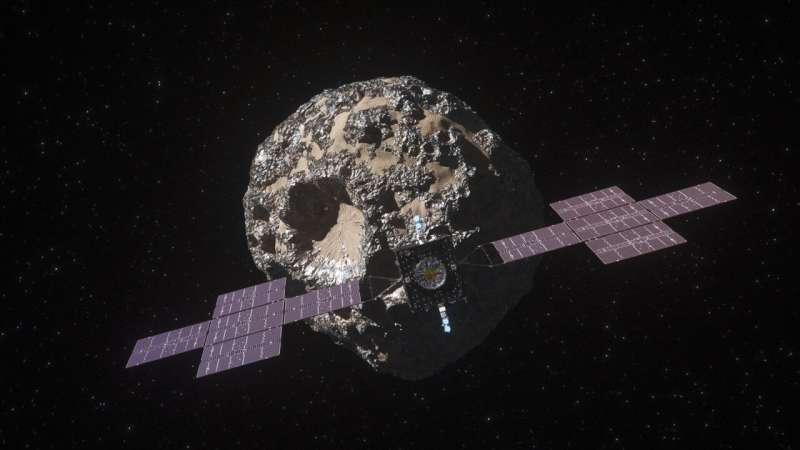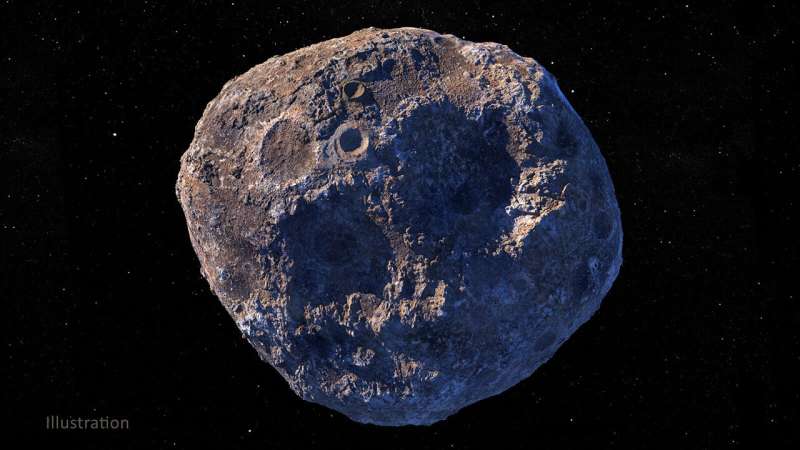This article has been reviewed according to Science X's editorial process and policies. Editors have highlighted the following attributes while ensuring the content's credibility:
fact-checked
trusted source
proofread
Shining a light on NASA's deep space demo

NASA's Psyche mission launched on 13 October 2023 on a journey to explore what could be the exposed metallic core of an ancient planet.
Riding along on board the Psyche spacecraft is an additional technology demonstration. NASA's Deep Space Optical Communication (DSOC) demonstration will test the use of lasers to transmit and receive more data with distant spacecraft than is possible with the radio waves currently in use.
Using a narrow laser beam to communicate with a spacecraft located 300 million km away presents a challenge on both interplanetary and quantum scales. However, if successful, the DSOC demonstration could unlock a world of new possibilities for future deep space missions.
ESA will participate in the DSOC demonstration in 2025 and work has begun to develop the required cutting-edge laser technology and ground infrastructure in Europe.
ESA joins deep space communication demonstration
"Fiber optic technology on Earth has enabled incredible data transfer speeds for applications like the internet," says Clemens Heese, the Head of the Optical Technologies section at ESA's European Space Operations Center in Darmstadt, Germany. "However, data transfer with spacecraft at interplanetary distances is still limited to the use of radio waves."
"We have already shown that optical communication can offer much higher data rates for Earth observation and telecommunications satellites in low-Earth orbits. But to use it at deep space distances, we need high-power, high-accuracy lasers and super-sensitive single-photon detectors that simply do not yet exist with the required performance."
By using pulses of light with a higher frequency than radio waves, optical communication enables the transfer of more data in a given time period. This higher data rate could allow future deep space missions at certain distances from Earth to carry more sophisticated scientific instruments and return significantly more data than is currently possible.
However, testing new technology on a deep space mission, where every kilogram of payload has to be very carefully selected, is a rare opportunity. NASA's DSOC is the first chance to build more trust in deep space optical communication and enhance its readiness for use in space flight.
ESA is participating in the DSOC demonstration to enhance European expertise both within and outside of the Agency. This involvement will enable future European solar system missions to consider using deep space optical communication and will boost European industrial capacity in the vital future technology sector of single-photon quantum optical communication.
Psyche: From Greek mythology to Greek mountain tops
ESA and NASA have a long-standing partnership in deep space communication and interoperability. This collaboration allows ESA spacecraft to communicate with NASA ground stations and NASA missions to communicate with ESA's Estrack stations, much like how European mobile phones are compatible with cellular networks in the U.S., and vice versa. This cross-compatible system ensures seamless communication across vast interplanetary distances and symbolizes strong international cooperation in space exploration.
By collaborating on the DSOC demonstration, the agencies are factoring this interoperability into the very early stages of the development of a new type of satellite communication.
Both agencies are developing their own ground infrastructure to communicate with DSOC. This ground infrastructure must be built at high altitude, in order to avoid as much interference from Earth's atmosphere and cloud cover as possible. For instance, NASA's facility is situated in the mountainous regions of California, capitalizing on the clear atmospheric conditions there.
To select a suitable site for ESA's ground infrastructure, the team began by looking at the most suitable optical telescopes in Europe that might be used to receive laser pulses from DSOC. The 2.3 m Aristarchos telescope, located at an altitude of 2,340 m at the Helmos Observatory in Greece, checked all the necessary boxes.
However, the team still had to find a suitable location for the high-power laser transmitter that will be used to send signals to the spacecraft. The high-power transmitter has to be located nearby, so that signals can be sent to and received from DSOC during the same communication window.
Fortunately, 37 km away from the Helmos observatory, across the valley and atop the next mountain peak, is the Kryoneri Observatory.
Work is now underway to prepare a single-photon-sensitive detector/receiver at the Helmos observatory and a high-power laser transmitter at the Kryoneri observatory.
ESA's deep space optical communication Ground Laser Receiver will take the form of a sophisticated receiver unit known as an "optical bench." This receiver unit will be securely mounted to the rear of the Aristarchos telescope.
"The receiver's detector must be highly sensitive to detect individual quantum particles of light—photons—from DSOC, sent across hundreds of millions of kilometers," says Sinda Mejri, the lead optical engineer of the ESA's Ground Laser Receiver system."
"To detect the individual photons, the detector needs to be superconducting, meaning it can conduct electricity without any resistance. To achieve this, the receiver's detector will be cooled to -272.15°C (1 Kelvin). Absorbing a photon disrupts the detector's superconducting state, creating a measurable electrical pulse."
"While one pixel, only a few microns in size, can achieve this sensitivity, our new detector requires 36 such pixels to work in unison, posing substantial challenges related to quantum mechanics and the required complex electronic circuitry."

Additionally, the detector faces the unique challenge of being cryogenically cooled, while still being able to move as the telescope turns and follows the spacecraft across the sky. Cryogenic systems typically resist movement, and ensuring consistent cooling during motion is another considerable technological challenge.
The Ground Laser Receiver also includes electronics to monitor the signal strength from DSOC. If the signal weakens, the system will automatically adjust the telescope's position to maintain signal strength and relay this information to the laser transmitter 37 km away, ensuring accurate alignment. This setup requires the development of specialized control software to coordinate these operations effectively.
The development of ESA's ground receiver started earlier this year. Once complete, it will be sent to NASA's Jet Propulsion Laboratory in California for compatibility testing with an engineering test model of the DSOC transmitter.
A laser pushing the limits of modern fiber optics
The development of the high-power laser transmitter at Kryoneri also poses a technological challenge.
"The laser has to be so powerful that it would actually break down the protective coating of its own optical components and mirrors and melt conventional fiber optics if not designed with the necessary precautions," says ESA Ground Laser Transmitter optical lead engineer Andrea Di Mira. "And we are combining up to seven separate beams that have to work together seamlessly."
With the seven beams combined, the ESA laser will be capable of transmitting photons encoded with information bright enough for DSOC to detect when it is roughly 1.5–2.5 astronomical units (220–370 million km) from Earth. These distances would be typical of a future Mars mission, for example. NASA believes it may be able to push the technology to even further distances.
In addition to the high brightness, the laser beam must be pointed precisely in the direction of the distant spacecraft. The required precision is like shining a laser pointer from Earth into a small crater on the moon.
Work has begun to prepare the site for the transmitter at Kryoneri. Once complete, the system will be tested at reduced power using the optical communication terminal of Alphasat, a European technology demonstration satellite now in geostationary orbit.
Europe up to the challenge
ESA's participation in the DSOC demonstration is made possible by a consortium of European companies including qtlabs, Single Quantum, General Atomics Synopta, qssys, Safran Data Systems and NKT Photonics Ltd, and by the National Observatory of Athens, who is providing access to the Helmos and Kryoneri observatories.
"We are really challenging European industry with this project," says Sinda Mejri. "But they have eagerly taken up the challenge. The work they carry out here could also give them an edge in the development of important technologies for applications such as Quantum key distribution, used for secure communications, and quantum imaging."
Deep-space optical communication is considered the most challenging form of optical communication. Its technology innovations, especially related to quantum optical communication, will directly benefit ESA's missions in this field, such as SAGA, Eagle-1, OPS-SAT VOLT or QKDSAT.
ESA's experiments with DSOC will take place in 2025, once the spacecraft is far enough from Earth to be representative of future deep space science and exploration missions.
If successful, the demonstration could pave the way for a new generation of solar system exploration and the development of deep space optical communication stations on Earth.
Journey to an ancient metal world
DSOC is riding along with NASA's Psyche mission but will not transmit Psyche mission data. The Psyche mission's primary goal is the exploration of the mysterious metal-rich asteroid of the same name.
Scientists believe that rocky, terrestrial planets such as Earth contain metallic cores, but their location so far beneath the surface makes them tough to study. The Psyche asteroid offers a rare chance to explore the history and formation of Earth-like planets.
Psyche was first discovered by Italian astronomer Annibale de Gasparis in 1852, as the 16th ever discovered asteroid. Almost two centuries later, Italy is now home to ESA's Planetary Defense Office who are particularly excited to see the results of the Psyche mission.
Humankind's understanding of asteroids is rapidly increasing: we are getting better at detecting small asteroids before impact with Earth, detecting ones that pass close by, getting up close to study them with spacecraft, and even returning asteroid samples to Earth.
The Psyche mission, and the DSOC technology demonstration with it, will enable a greater understanding of the origins of our universe and enhance our ability to transmit large quantities of scientific data back to Earth.
Provided by European Space Agency





















